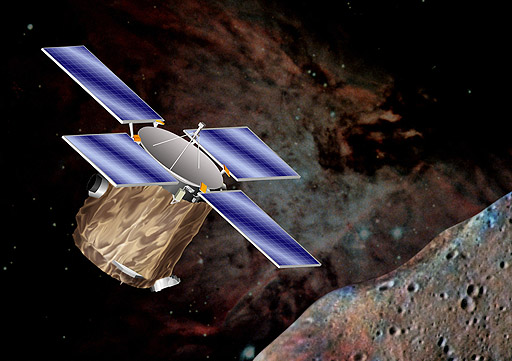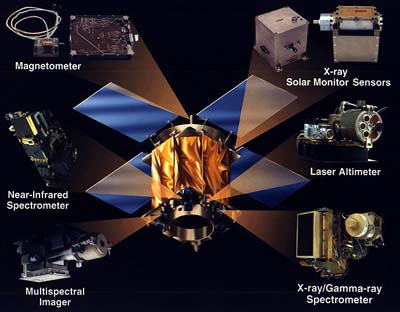
The Near-Earth Asteroid Rendezvous, or NEAR, was a joint mission between Jet Propulsions Labratory (NASA) and Johns Hopkins University. NEAR Shoemaker, a spacecraft built at the John Hopkins University Applied Physics Laboratory (JHU/APL), was a 1700 pound unmanned spacecraft launched ontop of a Delta II rocket from Cape Canaveral, Florida on February 17, 1996. The objective of this spacecraft was to intercept the asteroid Eros, fall into an orbit around the asteroid, and then study it. The mission was a complete sucsess, and ended with Shoemaker making a decent, and landing on Eros. It sent back hundreds of photos and instrument data that have helped scientists learn more about the history of our solar system. Today, this is the only mission mankind undertaken to land a spacecraft on an asteroid.

|
| NEAR Shoemaker (artistic rendering) |
Why send a spacecraft to an asteroid?
We have never been able to closely study an asteroid, especially a large one. We have been able to study meteorites (asteroids that have landed on Earth), and look at asteroids thruough telescopes. The NEAR mission had thee major goals: To determine what physical properties a near-earth asteroid has, find more information about how commets and asteroids are related, and to help determine the conditions in which our solar system formed. These goals needed information about asteroids that couldn't be gathered just by peering thru a telescope. So NEAR Shoemaker had an assortment of instruments that could find these answeres and then relay them back to mission control on Earth.
Why choose Eros as the target for NEAR?
Eros was targeted by the NEAR project for several reasons. Eros is the second largest known near-earth asteroid. Since its orbit brings it very close to Earth, it is much more easily accessible. The size of Eros is large enough that its gravity is able to support an orbit of a spacecraft. Most of the near-earth asteroids we have discovered are only about a half-mile across, where Eros is a large 'potato-shaped' asteroid mesauring 21 miles long, 8 miles wide and 8 miles thick. The timing of the NEAR project and the orbit of Eros made it the most suitable candidate for the mission.
 NEAR Instruments
NEAR Instruments

|
| Eros, taken from NEAR Shoemaker |
What was learned from Eros?
The surface of the asteroid looks a lot like what we would see on our Moon: craters and other complex features. Geologist Mark Robinson said at a Feb 19, 2000 conference, "There are tantalizing hints that the asteroid has a layered structure, like a sheet of plywood." And continues to describe how a layered structure is most likely a sign that Eros was part of a larger object, or a planet that was trying to form, but was fragmented off. This seems to fit with the theory that the asteroid belt between Mars and Jupiter was leftovers from a planet that may have tried to form over 4 billion years ago.
From radio data scientists found that Eros's density is 2.4 grams per cubic centimeter. This means that Eros is a very solid object, and not just a clumping of dust and small rocks, but a fairly unified piece of rock.
New questons and mysteries have been raised with the new data from Eros. One of the biggest was the apparent geological activity where craters on Eros have 'weathered' away. Craters on Eros have been created like any other celestial object's craters: by impacts of smaller objects (debris, etc.) On Eros scientits discovered that there are craters that seem to have degraded impact craters that show a sign of aging. This aging ususally occurs (like on Earth) by weathering (like rain erosion) or volcanic/techtonic activiy. Since Eros has no atmosphere, water, volcanic or techtonic activity, this raises quite a few questions as to how aging of a crater could occur.